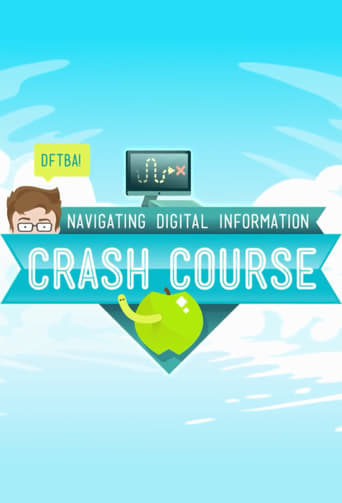

Watch similar TV shows
on Apple TV+ for free
In 10 episodes, John Green will teach you how to navigate the internet! We’ve partnered with MediaWise, The Poynter Institute, and The Stanford History Education Group to develop this curriculum of hands-on skills to help you evaluate the information you read online.
Crash Course Navigating Digital Information Season 1
With 30 Day Free Trial!
Crash Course Navigating Digital Information
2019
Watch similar TV shows
on Apple TV+ for free
In 10 episodes, John Green will teach you how to navigate the internet! We’ve partnered with MediaWise, The Poynter Institute, and The Stanford History Education Group to develop this curriculum of hands-on skills to help you evaluate the information you read online. By the end of this course, you will be able to: * Examine information using the same skills and questions as fact-checkers * Read laterally to learn more about the authority and perspective of sources * Evaluate different types of evidence, from videos to infographics * Understand how search engines and social media feeds work * Break bad internet habits like impatience and passivity, and build better ones

With 30 Day Free Trial!
Crash Course Navigating Digital Information Season 1 Full Episode Guide
Today, in our series finale, we're going to talk about the great white whale of navigating online information: your social media feed. Social media shapes both our online and offline behaviors from how we engage in communities and consume goods and services to influencing our thoughts and opinions. So let's talk about how they really function - the good stuff and also the terrible stuff.
The architecture of the social internet itself tells us not to be patient - to load more tweets, to hit refresh for new posts, and to click the top search results. But just because information is new, or algorithmically determined to be most relevant to you, doesn't necessarily mean it's the best or most accurate. So today we're going to teach you some tips to exercise a little more click restraint on the Internet.
Today, we're going to discuss how numbers, like statistics, and visual representations like charts and infographics can be used to help us better understand the world or profoundly deceive. Data is a really powerful form of evidence because it can be absorbed quickly and easily, but neither data, nor interpretations of it, are neutral, so today we're going to discuss how to think critically about the statistics we encounter in everyday life.
With the amount of fake and doctored photos and videos out there, how can we know what to trust? Most of us are used to thinking that "seeing is believing" but as technology makes it easier and easier to spread unreliable content online it's more important than ever for us to read laterally, check for context, and always fact check suspicious content - even if it looks real.
Today we’re going to focus on how to tell good evidence from bad evidence and maybe importantly, how to identify “Fine, but that doesn’t actually prove your point” evidence - the stuff that the Internet is built on.
Let's talk about Wikipedia. Wikipedia is often maligned by teachers and twitter trolls alike as an unreliable source. And yes, it does sometimes have major errors and omissions, but Wikipedia is also the Internet's largest general reference work and as such an incredibly powerful tool. Today we'll discuss using Wikipedia for good - to help us get a birds-eye view of content, better evaluate information with lateral reading, and find trustworthy primary sources.
In which John Green teaches you how to assess the sources of information you find on the internet. The growing suspicion of expertise is a growing problem on the internet, and it can be very difficult to figure out which sources are authoritative. In this episode John offers some strategies to help you identify credible sources and take into account a source's point of view.
Look to your left. Look to your right. Look at this video. Today, John Green is going to teach you how to read laterally, using multiple tabs in your browser to look stuff up and fact check as you read. Real-time fact-checking an help you figure out what's real and what's not on the internet.
We're off to fact-checking school. This time, John Green is teaching you how to fact-check like the pros. We're going to walk through the steps that professionals follow, including figuring out who is behind the information we read, why they're sharing that information, and what kind of evidence exists to back up the claim. We'll also talk about the difference between skepticism and cynicism.
We love the internet! It's a wealth of information where we can learn about just about anything, but it's also kind of a pit of information that can be false or misleading. So, we're partnering with Mediawise and the Stanford History Education Group to make this series on Navigating Digital Information. Let's learn the facts about facts!
Free Trial ChannelsAD
Seasons

















